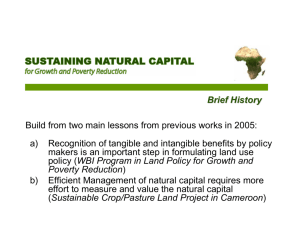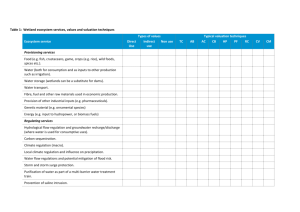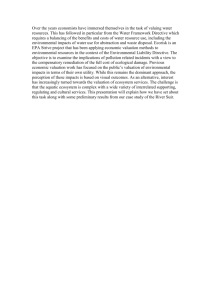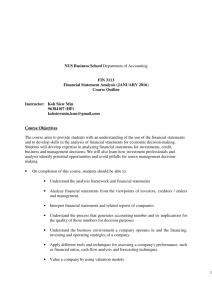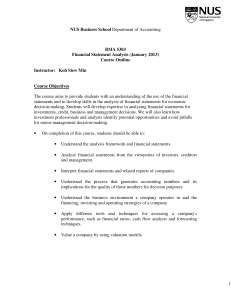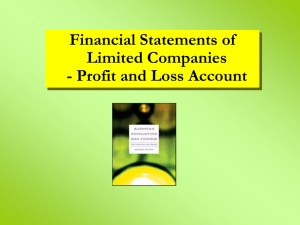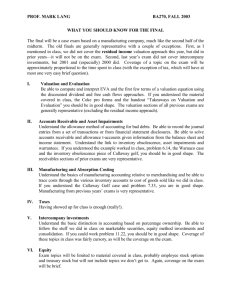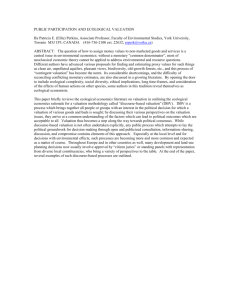A Contingent Valuation Study
advertisement
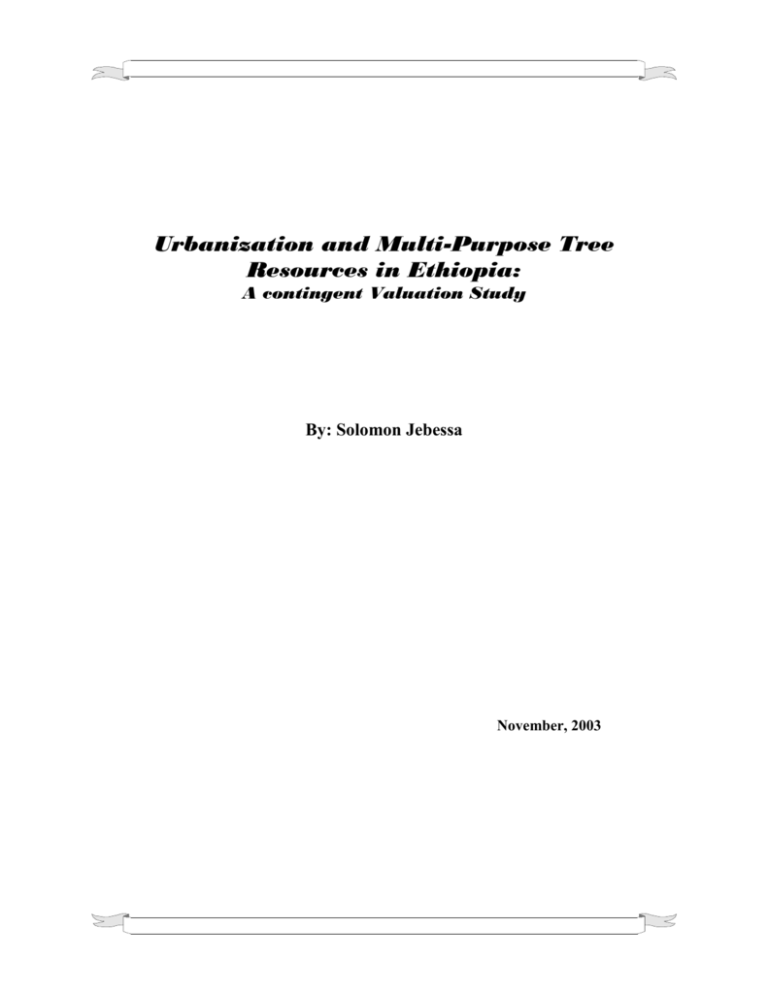
Urbanization and Multi-Purpose Tree Resources in Ethiopia: A contingent Valuation Study By: Solomon Jebessa November, 2003 CONTENT INTRODUCTION 3 PROBLEM AND JUSTIFICATION 4 OBJECTIVES 7 METHODOLOGY 8 Site Selection and Sampling Technique Method of Data Collection Data Analysis LITERATURE REVIEW 10 General Review On Valuation Of Non- Market Goods Theoretical review on CVM (Contingent Valuation Method) Empirical review on CVM (Contingent Valuation Method) BIBLIOGRAPHY 18 1) Introduction “Concern for the world’s forest has climbed to the top of the international policy agenda over the last fifteen years”(FAO 2002, P.III). Nowadays, multiple use is regularly mentioned in policy programs and action plans. Recently, international agreements on sustainable forestry have given a new demanding context to the expertise obtained in the field of multiple uses. Realization of the ideals of ecologically, economically and socially sustainable multiple use forestry requires adjustments in practical forestry as well as development of new forest policy practices. All trees can be described as potentially multi-purpose, but the potential uses of tree out side forests are more clearly evident. The wealth and diversity of their uses and services create a permanent, daily interaction with people that can be seen in production and research strategies, as in income mobilization (FAO 2002). In order to effectively manage a country’s or region’s use of its natural resources decision makers may attempt to take in to account the values for all aspects of the natural resources and understand how those values interrelate. At the household level welfare is derived from the use of natural resources for consumption and production. For policy makers it is desirable to understand how changes in polices will affect the welfare of households. In addition, economic valuation may be valuable in developing land use policies that will allocate resources effectively, efficiently and more equitably. Different groups use resources in different ways. If we are to attempt to estimate the total value of natural resources right all possible uses and services of the resources valued have to be incorporated. Multi-purpose tree resources out side forests are more intimately linked to the society around them than forest trees. People around the world are of one mind when it comes to the durability, availability and use of the goods and services provided by these multipurpose tree resources, whether inside or outside the forest. These men and women make no distinction between field trees and forest resources, perceiving the clear and close link between the two, and their interaction. Policy-makers and planners, however, tend to 3 view these resources as different entities. It seems clear that trees outside forests have not yet succeeded in arousing real interest at the top(FAO 2002). The apparent climate degradation that took place in the 1970’s provoked a rush of aid to countries hit by drought and desertification. Environment, sustainable development and biological diversity were high on the agenda of the 1992 United Nations conference on environment and development (UNCED) (FAO 2002). During the 1980’s and 1990’s interest mounted in non-wood forest products. Multipurpose trees, especially growing outside forests, began to be viewed in terms of their contribution to social well-being and to the environment. Policy makers and planners gradually evolved and converged in their thinking to acknowledge the promise of this resource, in all its myriad forms, as a key to multi sector sustainable development. Urban dwellers are increasingly recognizing and articulating the importance of urban forests as a vital component of the urban landscape, infrastructure and quality of life. Municipalities together with diverse stakeholders around the world have launched often quite ambitious urban forestry programs. Much progress has been achieved in urban forestry research and development in industrialized countries. However, multipurpose urban forestry in developing countries is still in its infancy. In addition, forestry work is conspicuously absent from urban development cooperation initiatives, despite the accelerated urbanization process taking place in developing countries. 2) Problem and Justification The World Bank estimates that in 1988 approximately one-quarter of the developing world's absolute poor was living in urban areas and projects that by the year 2000 this proportion will increase to one-half (WRI, 1996). Within the next 20 years more poor people will live in the cities than in rural areas. Increasingly, the lives of urban slum dwellers, street children and those forced to drift between the city and its fringes will characterize the face of global poverty. Urban areas generate environmental problems felt 4 at all levels from the household to the global. These problems range from impairment of human health, to economic and other welfare losses, to damage to the ecosystem. Air and water pollution and waste generation are among the key problems. Conversion of forests and farmland to urban development can also reduce water-permeable areas, upset natural drainage patterns and cause serious flooding. The broadest definitions regard urban forests as the entire forest area influenced by the urban population. In a more restricted sense, urban forestry relates to trees and woodland in towns and cities: garden and farm trees, street and park trees, remaining woodlands and emerging woodlands on vacant and derelict land Trees are an important part of the natural life support system, and they have a vital role in the sustainability of towns and cities. There is a growing recognition that urban forests improve the quality of urban life in many ways, providing both tangible (food, energy, timber, fodder) and less tangible benefits to meet local necessities. Multipurpose urban forestry is especially important for the urban poor. Tangible benefits Food. Fuelwood. Timber. Environmental services Microclimate and air quality improvement and carbon dioxide reduction. Water use, reuse and conservation. Soil conservation. Solid waste and land reclamation. Biodiversity. Social benefits Health.. Employment. Recreation. 5 Community building and property value improvement. In many instances, only the commercial value of the urban tree resource is considered in policy development. In order to develop policy that is beneficial for the entire population in the region, an estimation and understanding of the economic values for non-commercial uses of the urban forests and tree resources are also desirable. Successful forest projects and policies require careful identification of the target population and careful estimation of marketed and non marketed forest services and good effects on the household welfare.. The social, economical and ecological functions of the resources are all equally decisive in ensuring the quality of people’s lives, providing support for national economies and protecting the environment. And yet, multi-purpose tree resources remain a sort of out looked and hidden treasure. We are still unable to accurately assess either the resource itself or value the contribution of its products and services to the welfare of the society. And the same is true at the national level. Non-market resources valuation may be necessary because the importance and scarcity of the natural resources may not be captured in values indicated in formal markets. This is particularly the case in developing countries like Ethiopia where many natural resources are not traded in the market place for monetary value. What is needed, then, is an overall grasp of the socio economic and environmental implication of these resources at every level, a better understanding of what influences the valuation of society for the different goods and services of the multiple purpose tree resources. The challenge we face is, therefore, to value and assess the welfare implication of this multi-purpose tree resources to the society in the urban area and to identify factors affecting the valuation of the resources. There is no question that the integration of tree 6 out side forests in to the economic account and into development and conservation policy will have substantial environmental impact. Very few research works about economic valuation of forest in general are attempted out side Ethiopia. For Ethiopian case valuation of community forest is done using contingent valuation method (Alemu 2000). And very few other studies on economic valuation of forest using different approaches are done (Fissaha1997,Dunffa1998, Moges1999,Tegegne 1999,Essey 2000). Apart from this no attempt has been made to value multi-purpose tree resources in urban areas which are very intimate with the every day lives of urban society, who are expected to be the ultimate beneficiaries of this study. And also no attempt was made to value the different commodities and services from these resources and to identify factors affecting the valuation of the different commodities and services of these resources. In this study attempt will be made to elicit the Ethiopian urban society’s preference for the commodities (goods) and services from the multipurpose tree resources either inside or outside forests and factors that determine the willingness to pay for each commodities and services of the resources using contingent valuation method (CVM) to show the welfare implication of the resources. It will be, also, attempted to show its contribution to the Ethiopian national economy (account) at large. 3) OBJECTIVES Based on the above argument and problem discussed this study will try to address the following specific objectives. To identify the different commodities and services obtained from these multipurpose tree resources To assess the willingness to pay of the households for these resources and hence get the welfare implication of the resource on the household. 7 To identify factors affecting the willingness to pay for these resource (urban tree resource). To estimate the contribution of the urban multi-purpose tree resources to the national income account. 5) METHODOLGY 5.1 Site Selection and Sampling technique The study will be conducted in Addis Ababa, the capital city of Ethiopia. About 400 households will be selected using two stage sampling technique. The first stage is to select “kebeles” (lower administrative body) from each sub-town, and the second stage is to select households from the selected kebeles. 5.2 Method of Data Collection Three general measures of economic values associated with forest and tree covers change are commonly used. These are market prices, Surrogate or proxy market prices, and hypothetical value (Gregersen, Lundgren, Kengen and Byron 1997). In the absence of organized markets, an intuitively appealing approach to revealing the preference of individual is the use of contingent valuation method (CVM) (Mitchell and Carson, 1989).This technique use a hypothetical market situation to obtain bids from individuals indicating their willingness to pay (WTP) for a commodity 8 A questionnaire will be developed to capture the different socioeconomic and contingent valuation information from the sampled households. The questionnaire will be pre tested on few households and will be modified based on the feed back from the pre-testing. Enumerators will be recruited and well trained. Since the CVM questionnaire is difficult to administer the education level of the enumerators will be considered and the training will be intensive. Data will be collected with close supervision. 5.3 Data Analysis Mean and total willingness to pay will be calculated from the data collected Descriptive statistics will also be used to show the existing facts. Based on the data requirement Tobit or /and Probit models will be used to identify the determinants of the willingness to pay for the commodity and services from the multiple purpose tree resources. 6) Literature Review 6.1 General review on valuation of non- market goods A market is an exchange institution that serves society by organizing economic activity. Markets use prices to communicate the work and limits of a diffuse and diverse society so as to bring about coordinated economic decisions in the most efficient manner. The power of a perfectly functioning market rests in its decentralized process of decision making and exchange, no omnipotent central planner is needed to allocate resources. Rather, prices ration resources to those who value them the most and in doing so, individuals are swept along by Adam smith invisible hand to achieve what is best for 9 society as a collective optimal private decisions based on mutually advantageous exchange lead to optimal social outcomes (Hanley, Shogren and white 1997). However, for environmental assets markets can fail if prices do not communicate society’s desires and constraints accurately. As Hanley and Spash (1993) discussed prices often understate the full value of service provided by an asset or do not exist to send a signal to the market-place about the value of the asset. Market failure occurs when private decisions based on these prices or lack of them, does not generate an efficient allocation of resources. A key requirement to avoid a market failure is, therefore, that markets are complete. Enough markets exist to cover each and every possible transaction or contingency so that resources can move each and every possible transaction. There are two main arguments for putting a price on environmental goods such as water and air quality, biodiversity and natural environments. First, we need to know the marginal value of environmental goods to find the socially “right” (optimal) quantity/quality of different environmental goods. Second if environmental goods are not valued explicitly, they will still be valued implicitly through policy decisions. Since the decision makers are often not aware of that they make these valuation, this procedure produces an arbitrary and inconsistent set of prices (Navrud 1992). Economists have developed a variety of techniques to value non-market environmental and cultural amenities consistent with the valuation of market goods i.e. based on individual preference (Navrud 1992, Hanley and Spash 1993). Navrud (2000) discussed these valuation techniques rigorously based up on either observed behavior (Revealed preference, RP) towards some marketed good with a connection to the non-marketed good of interest, or stated preferences (SP) in surveys with respect to the non-marketed good while RP and SP techniques are based on individual preferences, and are rooted in welfare economics, other methods for economic valuation of environmental and cultural 10 amenities have also been proposed. Those methods are based on the preference of policy makers, scientific experts or specific interest groups (see table 1) Table I. I. Methods based on individual preferences In direct Direct Revealed Household production function (HPF) Simulated markets preference (RP) Approach Market prices Travel cost (TC) method Averting cost (AC) Hedonic price (HP) analysis Stated Contingent Ranking (CR) preferences (SP) Choice Experiments (CE) Replacement costs (RC) Contingent valuation (CV) Conjoint Analysis II. Methods based on decision makers /experts/ interest groups preferences. Reveled preferences Indirect - Implicit valuation (IV) Stated preference Direct - Delphi method Indirect -Multi criteria Analysis (MCA) For decades economists have grappled with the challenge of valuing public goods. The contingent valuation (CV) method is one of a number of ingenious ways they developed to accomplish the task. The contingent valuation method first came in to use in the early 11 1960’s when economist Robert K. Davis used questionnaires to estimate the benefits of out door recreation in a Maine backwoods area. Since the early 1970s the contingent valuation technique has been used by economists to measure the benefits of a wide variety of goods. CV circumvents the absence of markets for public goods by presenting consumers with hypothetical markets in which they have the opportunity to buy the good in question. Because the elicited willingness to pay (WTP) values are contingent up on the particular hypothetical market described to the respondent, this approach come to be called the contingent valuation method (Michael and Carson 1989) Until recent years most CV studies were exploratory, parallel theoretical work by many of the same researchers has established that CV data are generated in forms consistent with the theory of welfare change measurement (freeman 1979b)1 After more than 30 years of CV research the method has passed the experimental prototype stage, but has still not reached the routine application stage (Navrud 1992). There are no general guidelines for constructing reliable CV studies, although Michel and Carson (1989) provide some check points for evaluating CV survey. However, they emphasize that the presence of criteria for a good CV study may create overconfidence in those studies that meet those. Field application should, therefore, always be combined with methodological tests. Since the CV method at first sight seems very easy to use, it is vulnerable to misuse, which can easily undermine confidence in the method. The construction and framing of a CV survey should therefore be carefully examined before the results from it are used for policy purpose. It has many critics concerning inconsistency with rational choice, implausibility of responses, absence of a meaningful 1 As cited by Michael and Carson 1989 12 budge constraint, and information provision and acceptance extent of the market (NOAA 1993) According to Diamond and Hausman (1993) the CV method, in spite of the potential biases, if properly designed, offers a unique possibility for finding the “total value”, i.e. both use and non-use values of changes in environmental quality. Other major advantages of the method include the possibility of designing in to value future environmental changes (ex-ante analysis). 6.2 Theoretical review of CVM Each of the mainstream of non-market valuation has its theoretical framework Carson (1991) explains the theoretical foundation of using hypothetical market for welfare measurement and how to incorporate WTP and WTA by using the idea of “Constructed markets”. However Randall (1987) discussed this theoretical framework more rigorously and clearly. According to him the theoretical frameworks for the various methods are developed to different degrees and in different directions. Nevertheless, they all share one basic concept. Non marketed goods are represented in the utility function just as other goods are and were it not for conditions non rivalry, non exclusiveness or a political decision to provide and ration them independently of the market that distinguish them from ordinary goods they would be traded and valued in the same manner as market goods are. Introducing some non market good, Q, there are two ways to express the utility function. First U = U (Q, Y) Where Y is the “numeraire” or the value of all goods and services other than Q. This is the formulation implicit in the general value model. Second, we may write the alternative form 13 U = U (Q, Z) Where Z is a vector of ordinary goods. An equivalent formulation is U= U (P, Q, Y) Where P is a vector of prices of Z and Y is money income. These two ways to express the utility function suggest two different avenues to estimating the value of Q and thus the benefits (costs) of increments (decrements) in Q. One may attempt to estimate directly the total value curve. Alternatively one may use the second formulation of the utility function to extract indirectly information about the value of Q from observations of markets in Z. Contingent Valuation The total value curve is an indifference curve. For an individual initially enjoying Q0 and Y0, the total value curve indicate the benefit (cost) of increment (decrement) in Q as follows. U (Q0 ,Y0,) = U (Q- ,Y+) = U (Q+, Y-) = U (Q-, Y + WTA) = U (Q+, Y- WTP) Contingent valuation methods (CVM) attempt to determine the amount of compensation paid (WTP) or received (WTA) that will restore the initial utility level of an individual who experiences and increment or decrement in the level of Q. Because indifference curves are not ordinary observable, estimation methods using this approach usually make the searcher contrive situations in which experimental subjects or survey respondents reveal relevant points on their indifference surfaces. The researcher creates hypothetical or experimental markets. The level of Q is varied and the values recorded in these markets are treated as contingent values. 14 6.3 Empirical review on CVM. According to university of California department of economics there are more than 530 recent papers (from 1994-2001) concerning contingent valuation (CV) method for valuing non-market resources. Among these very few of them are devoted for using CVM for valuing environmental good specially forests. A study by Johansson, Kristrom & Matisson (1995) shows that many forest goods (services) have no market prices to reflect there value while timber is priced on the timber market the forest as an environment for recreation is a non-priced public goods. Besides “fully” priced and non-priced goods, there are “partially” priced goods, such as game for hunting. The article summarizes a number of Nordic studies which focus on the value of forest goods other than timber. Basically, it shows that two different methods, travel cost method and the contingent valuation method, have been used in the valuation of such goods. Campbell (1993) also discussed the potential valuation methodologies for valuing treebased resource and how CVM is more applicable to such kind of goods and services. Gregerson, Lundgren, Kengen and Byron (1997) and Dosman and Luckert (1999) critically analyses how to measure the relevant forest values. Concentrating on economic values, which are the most common ones issued in decision making and categories them in to three, which are market prices, surrogated or proxy market prices, and hypothetical value measures. Kohlin (1997) apply CVM to the Orissa Social Forestry Project (OSFP) and show how the method can be applied to support design and implemented for certain development project and that analysis of the bid function can give qualitative information that is difficult to identify by other methods. A more specific research work is also done by Lynam, Campbell and Vermeulen (1994) on how to apply CVM to elicit the preferences of Zimbabwean small holder farmers for 15 the commodities they obtain from trees. As the paper concludes, the use of contingent valuation method for valuing common access resource in the small holder farming sector can produce reliable and valid results. And as an out put of the paper non-market goods and services such as ecological services, social services and shade comprise a significant proportion of the total value to small holder households of the goods and services provided by tree resources. Very few research activities are done using CVM in Ethiopia and the application of this method on environmental issues is even very much limited. Alemu (2000) uses CVM to examine the determinants of the value of community forestry in rural Ethiopia and used its feasibility when plantations are established managed and used by the community themselves. As an out come of the study household size, household income, distance of homestead to proposed place of plantation, number of trees owned and sex of the house hold becomes the variables that explains the willingness to pay (WTP). Tegegne (1999) also apply this method to elicit people’s valuation for environmental protection in terms of both cash requirement and labour contribution. Fisseha (1997) and Dunffa (1998) are also applied CVM for measuring the willingness to pay for improved water quality in Maki town and Ada’a-Liben district respectively. In both studies income and time (distance) spent to fetch water comes out significant factors determining the willingness to pay of the household. Education and wealth were insignificant. In Fisseha`s study occupation and in Dunffa`s study family size and sex of the household were insignificant. Moges (1999) and Essey (2000) also used CVM to estimate the Willingness to pay for the Tana recreation site and for the reduction of air pollution in Wonj town respectively. They came up with their conclusion and recommendations. Generally little has been done to value natural resources in Ethiopia and hence this study is hoped to contribute something to this limited area of study and also to the little exeperianc of using CVM (Contingent Valuation Method) for valuing natural resources. 16 BIBLIOGRAPHY Alemu Mekonen (2000), “Valuation of Community forestry in Ethiopia: A Contingent Valuation Study of Rural Households”, Environment and Development Economics. 5(2000): 289-308 Bateman, I.J. and R. Kerry Turner (1993), “Valuation of Environment, Methods and Techniques: The Contingent Valuation Method”, in R. Kerry Turner (eds), Sustainable Environmental Economics and Management: Belhaven press, London. Carson, R.T. (1991), “Constructed Markets”, in J.B Braden and C.D. Kolstad,eds., Measuring the Demand for Environmental Quality, Elsevier Science Publishers, B.V., North Holland. Campbell B.(1993),“Monetary Valuation of Tree–Based resources in Zimbabwe; Experience and Out Look”, University of Zimbabwe, Paper Prepared for the FAO Expert Consultation on Non-wood Forest Products. Diamond, P.A. and J.A. Hausman (1993) “On Contingent Valuation Measurement of Nonuse Values”, in J.A. Hausman, eds., Contingent Valuation: A Critical Assessment North-Holland, New York Dosman .D and M.K Luckert (1999), “A Micro-economics Primer: An Introduction to Valuation Methods for Agro-Forestry Project in Developing Countries”, Institute of Environmental study (IES) Publications. Dunffa Lemessa (1998), “Estimating Willingness to Pay for Rural Water Supply: The Case of Ada`a-Liben District (Ethiopia)”, M.Sc Thesis, Dept. of Economics, Addis Ababa University. Essey Takele (2000), “The Valuation of Improved Air Quality: A Contingent Valuation Study on Wonji Town (Ethiopia)”.M.Sc Thesis, Dept. of Economics, Addis Ababa University. FAO (Food and Agriculture Organization)(2002). “Trees Outside Forests: Towards Better Awareness”. Conservation Guide, Rome. 17 Fisseha Abera (1997), “Estimating Willingness to Pay for Water: A 00Contingent Valuation Study on Meki Town (Ethiopia)”, M.Sc Thesis, Dept. of Economics, Addis Ababa University. Freeman III.A.M. (1993) The Measurement of Environmental and Resources Values. Theory and Methods, Washington, D.C.: Resources for the Future. Gregersen H., A.Lundgren, S.Kengen, N.Byron (1997), “Measuring and Capturing Forest Values Issues for the Decision-maker”, Xi World Forestry Congress, V.4, Topic 24.Antalya, Turkey. Hanley, N., F.J. Shgren and B. White (1997), Environmental Economics in Theory and Practice, Macmillan press Lt.d. U.K. Hanley, N. and C.L. Spash (1993). “Cost-Benefit Analysis and the Environment”, Cheltenham, UK. Northampton, MA, USA. Johansson, Per-olov, B.Kristrom and L.Matisson (1995), “Economic Values of NonTimber Forest Goods And Services .In: Hytonen, M (Ed)”, Multiple-Use Forestry in the Nordic countries, METLA, Finnish Forest Research Institute, Helsinki: Research center. p, 343-355. Kolstad. C. D, (2000) “Environmental Economics”, Oxford University press, New York Kohlin .G. (1997), “Contingent Valuation In Project Planning And Evaluation- The Case of Social Forestry In Orissa, India”, Studies in Environmental Economics and Development, Environmental Economics Units, Department of Economics, Gothenburg University Working Paper. Lynam T.J.P., Campbell B.M. and S.J. Vermeulen (1994), “Contingent Valuation of Multipurpose Tree Resources in the Smallholder Farming Sector, Zimbabwe”, Studies in Environmental Economics and Development, Environmental Economics Units, Department of Economics, Gothenburg University Working Paper. Mitchell, R.C. and R.T. Carson (1989), Using Surveys To Value Public Goods: The Contingent Valuation Method, Washington D.C.: Resources for the Future. 18 Moges Shiferaw (1999), “Economic Valuation of Environmental Goods as Outdoor Recreation. A contingent Valuation Approach: A Case Study of Lake Tana (Ethiopia)”, M.Sc Thesis, Dept. of Economics, Addis Ababa University. Navrud, Stale. (2000): “Strengths, Weaknesses and Policy Utility of Valuation Techniques and Benefit Transfer Methods”. In OECD (2001): Valuing Rural Amenities. Proceedings from OECD-USDA workshop: Value of Rural Amenities: Washington D.C., Navrud, Stale (ed). (199, “Pricing the European Environment”, Scandinavian University Press/ Oxford University Press. NOAA (1993), “Report of the NOAA Panel on Contingent Valuation” Federal Register 58:4601-4614 NUFU. 1998. Trees matter. The benefits of trees & woods in towns. London, National Urban Forest Unit. Randall, Alan (1987), Resource Economics: An Economics Approach to Natural Resource and Environmental Policy Tegegne G/Egziabher (1999), “Willingness to Pay for Environmental Protection: An Application of Contingent Valuation Method (CVM) in Sekota District, Northern Ethiopia”, Ethiopian Journal of Agricultural Economics, V.3 No. 1. University of California Department of Economics. (2001), “Recent Literature on Contingent Valuation Methods for Valuing Environmental Goods”, Los Angeles. WRI. 1996. World Resources 1996. Washington, DC, World Resources Institute. 19

